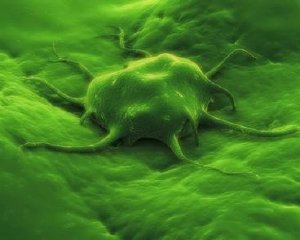Sep 21 2009
For the past 40 years, cancer research at MIT has focused on identifying the molecular mechanisms that cause the disease. While that is still a hot research field, the focus is now expanding. MIT researchers are trying to "not only understand how cancer develops and how it undergoes metastatic spread, but to use our knowledge in new ways to diagnose and treat the disease," says Institute Professor Phillip Sharp, a member of MIT's David H. Koch Institute for Integrative Cancer Research.
 Photo - istockphoto.com
Photo - istockphoto.com
Cancer biologists like Sharp are working with their engineering colleagues at the Koch Institute to develop a new arsenal of powerful weapons, including tiny strands of RNA that can shut off cancer genes, and new types of homing nanoparticles that can deliver drugs directly to tumors. In effect, MIT cancer researchers have reached a possible turning point in the long struggle against the disease: through the use of new technologies, ideas and ways of working, they hope to turn as many types of cancer as possible from a death sentence to a chronic but controllable illness.
"We're poised with more drugs, more insights, and more new ways of dealing with disease, than we ever have been before," says Sharp.
Each year in the United States, more than a million people get a cancer diagnosis, and the disease kills about half a million people. With a few exceptions, cancer death rates have changed little in the past 40 years, despite billions of dollars spent on research as part of the much-publicized "war on cancer" President Richard Nixon declared in 1971.
"At the time there was much hope — some misplaced — that we were about to understand the answers to cancer, and dramatic changes were just around the corner," says Robert Weinberg, the Daniel Ludwig Professor of Biology, who has been at MIT since 1972.
When MIT's Center for Cancer Research was founded in 1974, its mission was to reveal the molecular workings of cancer cells. "At MIT we followed precisely this route — trying to figure out what causes the disease rather than attempting to devise new cures," Weinberg says of the past several decades. "If you don't understand these molecular mechanisms, the prospects for new kinds of therapy and drugs are really limited."
During that span, cancer researchers at MIT and around the world have learned a great deal about how cancer forms and spreads, but that understanding has too infrequently translated to new treatments. In fact, the more scientists learn about cancer, the more they realize how difficult it is to battle the disease, which most researchers and oncologists no longer think of as a single disease.
"The original program was naïve in the sense that cancer was not appreciated to be really an incredibly vast collection of diseases. Cancers of different cells and tissues can be quite different from each other," says Tyler Jacks, director of the Koch Institute. (The MIT Center for Cancer Research became the Koch Institute in 2007.)
The Koch Institute, which is scheduled to move into a new building on MIT's campus in December 2010, represents a unique approach to cancer research. With biologists and engineers working side-by-side, the hope is that engineering tools such as computation, nanoscale fabrication and high-resolution imaging will help cancer biologists more rapidly translate their knowledge of cancer cells to new treatments and diagnostic tools.
"These engineers insist on fixing things," says Sharp. "They're really committed to finding new ways of detecting and treating disease and measuring its progress and imaging its development in the body."
For example, Institute Professor Robert Langer, a chemical engineer, is developing targeted nanoparticles that can deliver drugs to prostate and ovarian tumors, and Michael Cima, professor of materials science and engineering, is working on tiny implantable devices that can monitor long-term tumor growth and metastasis.
Research is also underway to untangle the hodgepodge of mutations that can lead to different types of cancer. Recently, biology professors Michael Yaffe and Michael Hemann showed that identifying two specific mutations in cancer patients could help doctors figure out which drugs will be most effective for individual patients.
Another promising field is RNA interference, which could enable scientists to turn off cancer-causing genes by blocking them with short strands of RNA.
New types of cancer treatment and diagnostic tools generally require years of testing before they are approved for use in patients, but Jacks says he is impressed by the steady progress of treatments now in the pipeline. Some potential new treatments, such as RNA interference and targeted nanoparticle drug delivery, could be ready for patients in the next three to five years, he says.
"We can never be certain that results in people will play out 100 percent of the time," he cautions. But he's encouraged that prospective treatments have entered or will soon enter clinical trials. "This is not just research for research's sake, or technology development in a vacuum. Our goal is to advance new discoveries and new technologies to the benefit of cancer patients in the near term."